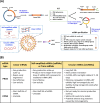Current landscape of mRNA technologies and delivery systems for new modality therapeutics
- PMID: 39256822
- PMCID: PMC11389359
- DOI: 10.1186/s12929-024-01080-z
Current landscape of mRNA technologies and delivery systems for new modality therapeutics
Abstract
Realizing the immense clinical potential of mRNA-based drugs will require continued development of methods to safely deliver the bioactive agents with high efficiency and without triggering side effects. In this regard, lipid nanoparticles have been successfully utilized to improve mRNA delivery and protect the cargo from extracellular degradation. Encapsulation in lipid nanoparticles was an essential factor in the successful clinical application of mRNA vaccines, which conclusively demonstrated the technology's potential to yield approved medicines. In this review, we begin by describing current advances in mRNA modifications, design of novel lipids and development of lipid nanoparticle components for mRNA-based drugs. Then, we summarize key points pertaining to preclinical and clinical development of mRNA therapeutics. Finally, we cover topics related to targeted delivery systems, including endosomal escape and targeting of immune cells, tumors and organs for use with mRNA vaccines and new treatment modalities for human diseases.
Keywords: Lipid nanoparticles; New modality therapeutics; Targeting mRNA delivery systems; mRNA Technology; mRNA therapeutics.
© 2024. The Author(s).
Conflict of interest statement
The authors have declared no conflicts of interest.
Figures





References
-
- Wood H. FDA approves patisiran to treat hereditary transthyretin amyloidosis. Nat Rev Neurol. 2018;14(10):570–570. - PubMed
-
- Mullard A. Pfizer’s COVID-19 vaccine secures first full FDA approval. Nat Rev Drug Discovery. 2021;20(10):728. - PubMed
-
- Moderna I. Moderna Receives Full U.S. FDA Approval for COVID-19 Vaccine Spikevax. <https://investors.modernatx.com/news/news-details/2022/Moderna-Receives-...>. 2022. Accessed 31 Jan 2022.
Publication types
MeSH terms
Substances
Grants and funding
LinkOut - more resources
Full Text Sources

